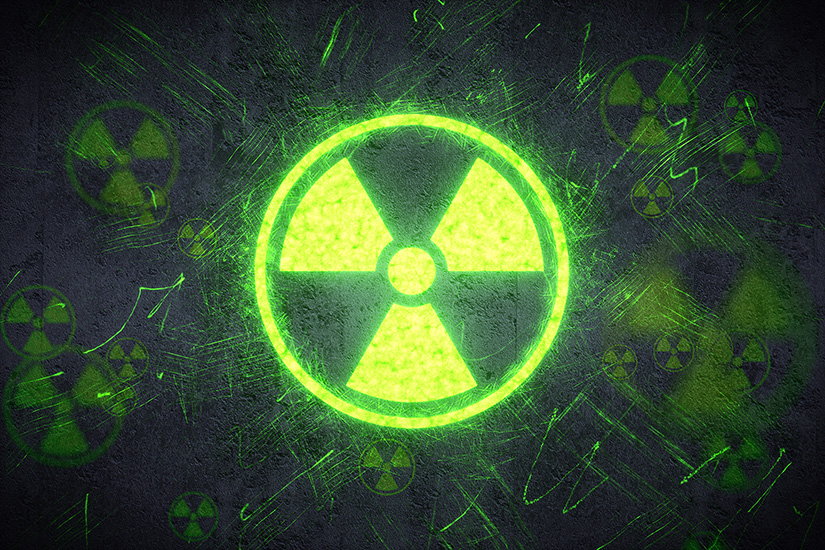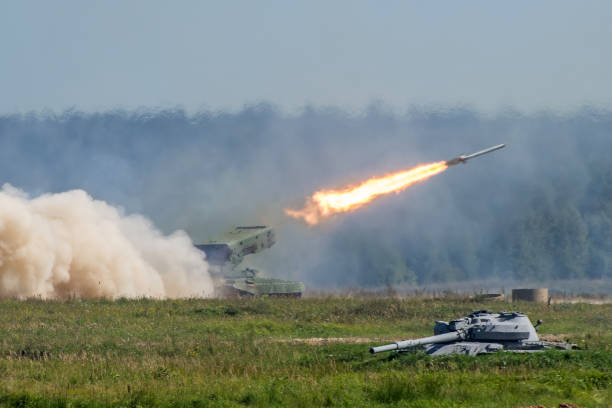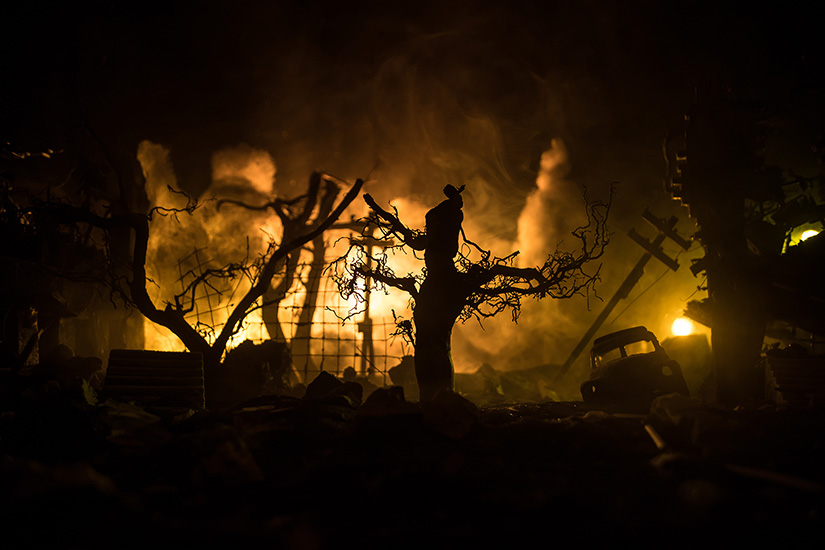Since Russia launched its invasion of Ukraine on February 24, the nuclear threat has rapidly become more real. On February 27, President Putin instructed the military’s nuclear deterrence units, including the nuclear force, to go on high alert in order to be ready to execute their mission. On the same day, Belarus abolished the clause in its Constitution prohibiting the deployment of nuclear weapons in the country, which suggested the possibility of the forward deployment of Russia’s nuclear weapons in Belarus[1]. The situation is truly beginning to look like “a military aggression under nuclear saber-rattling[2].” The aim of Russia’s invasion of Ukraine is not to occupy and govern the entire territory of Ukraine; it seems to be to apply military pressure on Ukraine to force it to accept the will of Russia. On the other hand, it is not Ukraine that Russia intimidated by bringing its nuclear force to the fore; on the contrary, this was probably a signal to the international community, in particular the NATO countries. Russia wants pro-Russian regimes, so its true intentions are probably not to stir up the hatred of the people of Ukraine, and Russia mentioned its nuclear force in order to constrain the actions of Europe and the United States. Actually, President Putin stated on February 27 that “Western countries are not only taking unfriendly actions in the economic sphere against us but also NATO is making aggressive statements,” and before this on February 24, he warned any countries interfering with Russia’s invasion that they would face “consequences that you have never experienced in your history[3].” How likely is it that Russia will use nuclear weapons?

Strategic nuclear weapons and tactical nuclear weapons
The important point here is that there is a large difference between long-range strategic nuclear weapons, in particular intercontinental ballistic missiles, and tactical nuclear weapons with a much shorter range. Both the United States and Russia prohibited possession of missiles with the range of 500km to 5,500km under the Intermediate-Range Nuclear Forces Treaty (INF Treaty) from 1988 to 2019. For this reason, the missiles capable of carrying nuclear warheads possessed by the two countries are currently limited to those with a range of more than 5,500km, equivalent to the distance from the north coast of Russia to the borders of the United States and Canada (strategic nuclear weapons) or conversely short-range missiles with a range of less than 500km which cannot reach Moscow from the territory of the NATO countries or reach major cities inside NATO such as London, Paris, etc. from Russian territory (tactical nuclear weapons)[4].
Concerning the former ones, or strategic nuclear weapons, a sophisticated deterrence theory was assembled under the bipolar structure consisting of the United States and the Soviet Union in the Cold War period and it is thought that this has functioned effectively. This was the Mutual Assured Destruction (MAD) structure under which, in the case that hostilities were commenced by either of the two countries, both countries would be certain to suffer intolerable damage (20% to 25% of their population and 50% of their industrial infrastructure) due to the return attack by the nuclear forces which survived the first strike.
In contrast to this, tactical nuclear weapons are designed for clashes between one military and another, not attacks against soft targets such as cities and industrial infrastructure. Moreover, because their range is restricted to less than 500km, they do not have the capability to destroy the major cities and other social infrastructure of the adversary from their home country’s territory within the European theater of operations. Their destructive power is also comparatively small, and their collateral damage is also small if compared to strategic nuclear weapons, so they have been treated as weapons envisioned for use on the battlefield.
The fear of tactical nuclear weapons as the weapons of the weak
It is not often discussed, but tactical nuclear weapons are the weapons of the weak. During the Cold War, the conventional forces of the Warsaw Treaty Organization (WTO) military had an overwhelming numerical advantage over NATO, and it was thought that it would be difficult to repel a WTO attack only with the conventional forces of the Western countries. For this reason, the use of tactical nuclear weapons was an important element of NATO defense, including the possibility of the Western countries stopping an attack by using nuclear weapons inside the territory of their own camp; for example, inside the territory of the former West Germany. Therefore, the Western countries never discarded the option of using tactical nuclear weapons before the adversary.
After the end of the Cold War, this structure was reversed, and the Russian side began to hint that it would use nuclear weapons in the case that this was unavoidable for its defense. The security policy of Russia from the 1990s onwards was predicated on the fact that its conventional military forces were relatively inferior, and the military doctrine released in 2000 stated that Russia “reserves the right to use nuclear weapons in response to large-scale aggression utilizing conventional weapons in situations critical to the national security of the Russian Federation[5].” We can conclude that using nuclear forces to compensate for the inferiority of the conventional military forces has become the declared policy.
At first glance, it appears reasonable that the weak would depend on nuclear forces. However, speaking in relation to the invasion of Ukraine, it seems that the condition for the use of nuclear forces in the declared policy of Russia, namely that the situation is “critical to national security,” has been interpreted in a very broad and aggressive way. Basically, it even sounds like Russia will resort to the use of nuclear forces if that is necessary in order to employ military force against Ukraine with the objective of turning it into a pro-Russian state. In other words, it is nothing other than the threat that Russia will use its nuclear forces if NATO, which has conventional forces superior to those of Russia, resists Russia’s attempt to change the status quo by force. If the international community tolerates this kind of logic, which is similar to “a thief becoming violent when detected while attempting a burglary,” it will lead to serious problems in the future.

The fear of escalation
One more problem is escalation. No matter how small-scale they are, if nuclear weapons are actually used, it will be the first time since Hiroshima and Nagasaki. There is a big danger that if nuclear weapons are used, they will cause a serious shock to the enemy side, resulting in a fiercer use of nuclear forces, and then this will rapidly expand to retaliations using strategic nuclear weapons between the two countries of the United States and Russia. Formerly, Russia also perceived this danger. The military doctrine of Russia published in 1993 states that “any, including limited, use of nuclear weapons in a war by even one side may provoke the massive use of nuclear weapons and have catastrophic consequences[6].”
The frightening fact is that it seems that recently Russia has been lowering the height of each step on the escalation ladder in an attempt to control the escalation. Moreover, Russia is trying to stir up the fear of the adversary using small escalations in order to make it act in accordance with Moscow’s own will. According to a recent study by the Center for Naval Analysis (CNA), a think tank in the United States, Russia raises as an option the threat of the destruction of critical targets using means including nuclear forces from a comparatively early time in the phases from peacetime to nuclear war, namely, from the stage of deterring military action by the adversary when there is a crisis, and Russia anticipates escalation from the threat of the use of nuclear weapons to the large-scale use of tactical nuclear weapons at the stage of a localized war or worse[7]. Taking into account the fact that a “demonstration attack” against a region with a sparse population is included in this kind of option, we cannot be optimistic about the current situation[8].

The fear that lies behind the motivation for the invasion of Ukraine
There are circumstances which make the shadow of tactical nuclear weapons even more somber. If we suppose that the purpose of the present invasion is to stop Ukraine moving closer to NATO, and that behind this is the threat perception of President Putin, which could even be described as paranoia, then the problem is serious. Seen from the Russian side, Ukraine is located between the NATO countries and Russia. The distance between Kiev and Moscow is approximately 500km, which is equivalent to the range of the weapons treated as tactical nuclear weapons under the INF Treaty. If we suppose that President Putin is seriously concerned that the tactical nuclear weapons of NATO will be deployed in Ukraine, putting Moscow within their range, then there is no way out, and actually that concern does not make sense, so the result will be that the security interests of both Russia and NATO will be harmed. This is very nature of the dynamic of the so-called “security dilemma[9]” under which actions purely taken for the purpose of one’s own security invite a less secure situation as a result.
Firstly, considering the fact that both Russia and NATO can possess intermediate-range missiles because they are no longer bound by the INF Treaty, there is little point in establishing a buffer between Russia and NATO. This is because the threat of intermediate-range missiles at least cannot be removed. That being so, there are concerns of an arms race in this field.
Moreover, now when mutual relations have become hostile and suspicion is maximized due to Russia’s invasion of Ukraine and the strong opposition of the international community to it, the barriers for stopping escalation are extremely thin. This is because President Putin has already escalated to the level of a nuclear threat. The military doctrine of Russia presents as options for the next stage the use of nuclear forces for the purpose of demonstration and the limited use of nuclear forces against enemy military power[10]. We must not fail to consider the situations involving those kinds of use of nuclear forces.
(2022/5/30)
Notes
- 1 “Belarus referendum approves proposal to renounce non-nuclear status – agencies,” Reuters, February 28, 2022.
- 2 Hirofumi Tosaki, “Russia's Military Aggression against Ukraine and Nuclear Saber-rattling,” The Japan Institute of International Affairs, JIIA Strategic Comments (2022-02), March 2, 2022.
- 3 Michael O’Hanlon, “Putin is angry, but he isn’t mad,” The Wall Street Journal, March 9, 2022.
- 4 Due to the expiration of the INF Treaty, the constraint on both countries prohibiting the possession of intermediate-range missiles ceased to exist. For this reason, going forward, it is possible that both countries will introduce missiles with intermediate ranges. Note that the United States had been repeatedly pointing out for some time that Russia was developing missiles with a range of 500km or more in violation of this obligation and also that China and North Korea were not subject to this constraint.
- 5 Yu Koizumi, “Trends in Discussions concerning the Nuclear and Non-Nuclear Escalation Deterrence Concepts of Russia” in The Japan Institute of International Affairs “Russia in an Era of Great Power Competition” (FY2020 Ministry of Foreign Affairs Subsidy Scheme for Study/Research on Foreign Policy and Security: Research Report), March 2021, p. 96: Table 2.
- 6 Ibid.
- 7 The study by CNA cites the “threat of damage infliction to vitally-important objects with non-nuclear means and nuclear weapons” as an option in the phase of “deterrence of military threat” which constitutes the next stage at times of peace. Michael Kofman, Anya Fink and Jeffrey Edmonds, Russian Strategy for Escalation Management: Evolution of Key Concepts, Center for Naval Analysis, April 2020, Figure 5, p.26.
- 8 Koizumi, op. cit.
- 9 The “security dilemma” refers to a chain of events triggered when the measures taken by a state purely to strengthen its defense posture invite the suspicion of other countries and prompt those countries to take the option of an arms buildup. The dynamic is that the result of this is a vicious circle in which the country that took action first is also forced into a further arms buildup, inviting a yet another reaction from the other party, and finally conflict becomes unavoidable or the consequence is a more dangerous situation than when the first country took action because it thought self-defense was necessary.
- 10 Michael Kofman, Anya Fink and Jeffrey Edmonds, op. cit.

